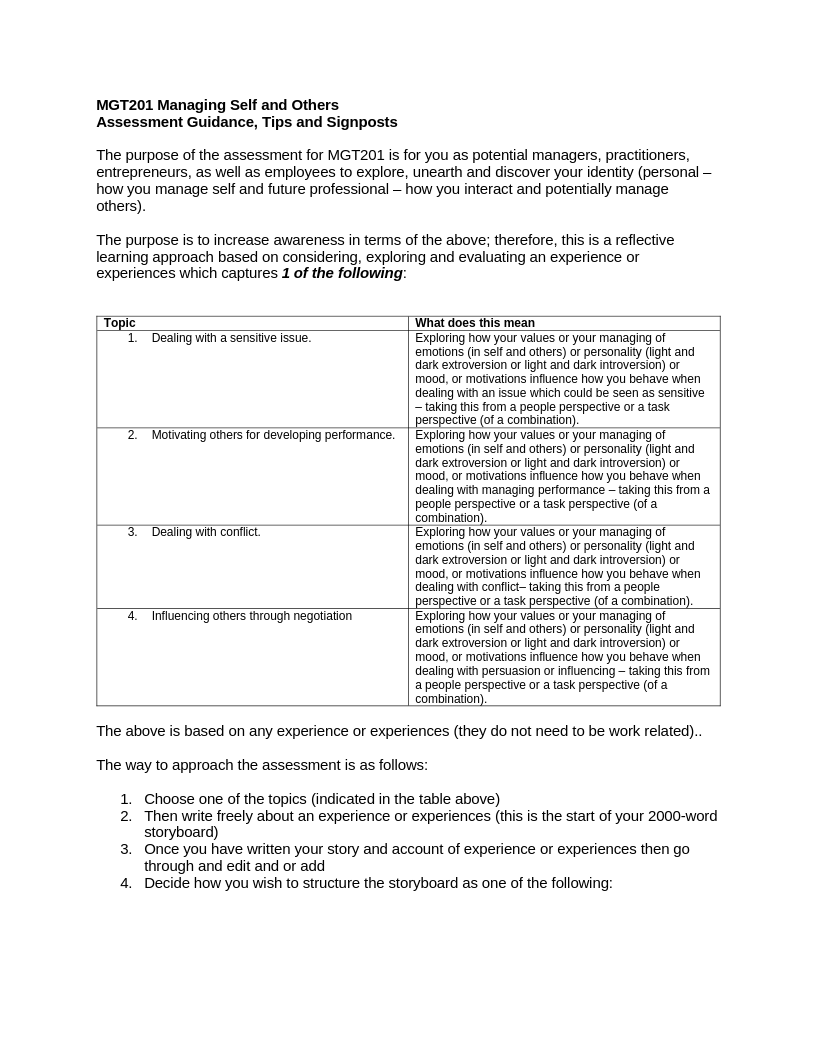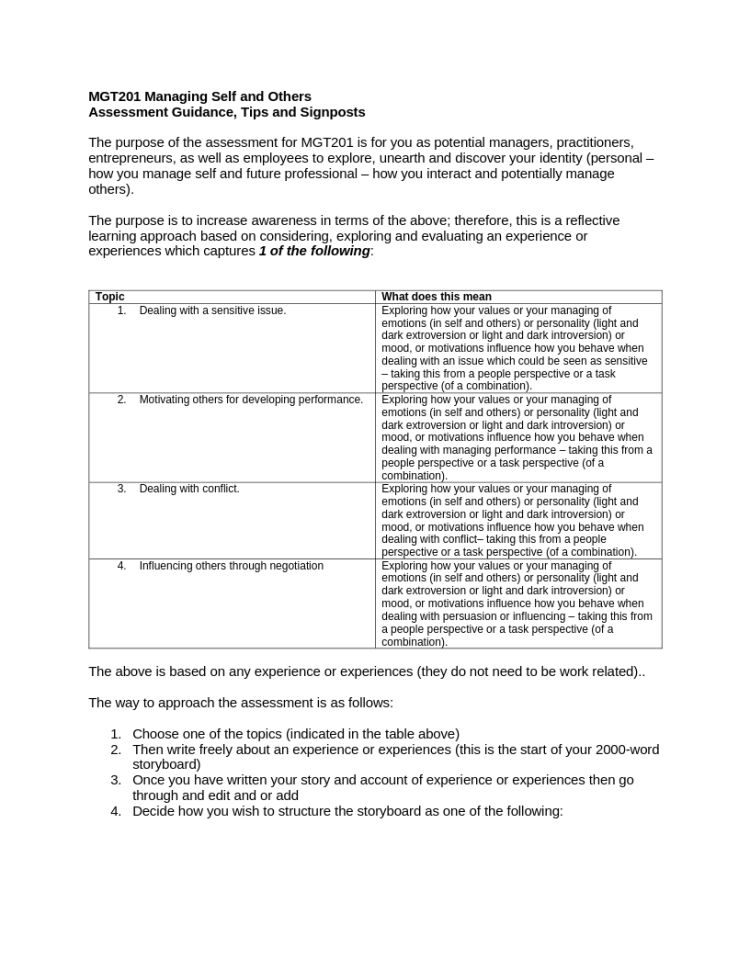
MGT201 Managing Self and Others
Assessment Guidance, Tips and Signposts
The purpose of the assessment for MGT201 is for you as potential managers, practitioners, entrepreneurs, as well as employees to explore, unearth and discover your identity (personal – how you manage self and future professional – how you interact and potentially manage others).
The purpose is to increase awareness in terms of the above; therefore, this is a reflective learning approach based on considering, exploring and evaluating an experience or experiences which captures 1 of the following:
|
Topic |
What does this mean |
|
Exploring how your values or your managing of emotions (in self and others) or personality (light and dark extroversion or light and dark introversion) or mood, or motivations influence how you behave when dealing with an issue which could be seen as sensitive – taking this from a people perspective or a task perspective (of a combination). |
|
Exploring how your values or your managing of emotions (in self and others) or personality (light and dark extroversion or light and dark introversion) or mood, or motivations influence how you behave when dealing with managing performance – taking this from a people perspective or a task perspective (of a combination). |
|
Exploring how your values or your managing of emotions (in self and others) or personality (light and dark extroversion or light and dark introversion) or mood, or motivations influence how you behave when dealing with conflict– taking this from a people perspective or a task perspective (of a combination). |
|
Exploring how your values or your managing of emotions (in self and others) or personality (light and dark extroversion or light and dark introversion) or mood, or motivations influence how you behave when dealing with persuasion or influencing – taking this from a people perspective or a task perspective (of a combination). |
The above is based on any experience or experiences (they do not need to be work related)..
The way to approach the assessment is as follows:
- Choose one of the topics (indicated in the table above)
- Then write freely about an experience or experiences (this is the start of your 2000-word storyboard)
- Once you have written your story and account of experience or experiences then go through and edit and or add
- Decide how you wish to structure the storyboard as one of the following:
|
Professional Identity |
Personal Identity |
|
This is where you draw from the professional standards from one of the professional bodies related to ‘Management’ which is either: Marketing – Chartered Institute of Marketing (CIM) https://www.cim.co.uk/membership/global-professional-marketing-framework/ Management – Chartered Management Institute (CMI) https://www.managers.org.uk/education-and-learning/professional-standards/ Financial Management – The Association of Chartered Certified Accountants (ACCA) https://www.accaglobal.com/uk/en/about-us/regulation/ethics/acca-code-of-ethics-and-conduct.html HRM/HRD/OD (People Management) – Chartered Institute of Personnel and Development (CIPD) |
This is drawing from the self-images cited within the article by Pettica-Harris and McKenna (2013) – this article is located within the MGT201 Library Reading List for Week 5. The 7 self-images are: Self-doubters Strugglers Surfers Storytellers Strategists Stencils Soldiers The descriptions of these self-images is located with the article (so please read!) |
Once you have decided you wish to structure your storyboard either as professional identity or personal identity then consider whether you are approaching the coding and data as follows:
|
Individual Differences |
Diagnostics (Traditional Reflective Learning) |
Poetics (metaphorical and Artful Reflective Learning) |
|
Emotions (including mood) |
Extracts from diagnostics related to emotions (EI, SI, Mood), personal resilience, controlling emotions, stress management, assertiveness, management skills |
Can use any artful poetic as extracts from poetry, lyrics, drawings, photographs, proverbs, religious text, extracts from plays, novels, films, television please note: for international students you can use poetics from your culture and your language, all I ask is you translate into English |
|
Personality (light and dark introversion or extroversion) |
Extracts from diagnostics related to personality |
Can use any artful poetic as extracts from poetry, lyrics, drawings, photographs, proverbs, religious text, extracts from plays, novels, films, television please note: for international students you can use poetics from your culture and your language, all I ask is you translate into English |
|
Values, beliefs, motivations |
Extracts from diagnostics related to values, motivation to work, management skills |
Can use any artful poetic as extracts from poetry, lyrics, drawings, photographs, proverbs, religious text, extracts from plays, novels, films, television please note: for international students you can use poetics from your culture and your language, all I ask is you translate into English |
You can combine the individual differences (however do not try and cover all as this would make your reflection too messy).
You can also structure your reflection using a metaphor (which could include the use of characters) …
You can present your reflection (storyboard) as a play, a chapter from a book, a diary, an album (lyrics or photos), an art exhibition, there are many imaginative, artful and metaphorical ways to present. You do not achieve a higher grade by doing this, your grade is determined by how much depth of theoretical understanding you demonstrate.
PLEASE NOTE: In the 2000-word Reflective Storyboard you have NO References (academic citations) you source your data (diagnostics or poetics) as follows:
Diagnostics:
(Source: Extracted from Motivation to Work Test, located at https://mbaworld.careercentre.me/Members, Accessed 21st February 2025)
Poetics (e.g. a lyric):
(Source: Wake by Arcade Fire, 2004)
This would be the same for all textual based poetics, for a visual poetic, e.g. a photograph it would be:
(Source: Taken from Personal Album, date photograph was taken)
You complete the reflective storyboard first, once you have done this then you:
- Write your 1000-word introduction which is the theoretical understanding of how you recognize the reflective learning approaches (swampy lowlands, reflection, in, on and through action, critical altering perception, artful, metaphorical) and connect this with academic literature with your individual differences approach – expecting to have academic citations throughout this 1000 words
- Once you have completed this then complete the table as follows:
JOHARI Window Coding Table (not counted in the word count)
|
JOHARI Window Pane |
Colour or Bold or Italics |
Reason [1] |
|
Open |
Outline where this pane would be seen by either using colours or bold or italics, in terms of whether this is professional or personal identity and make connections with individual difference(s) – if you have structured as a metaphor – outline and explain the metaphor |
Outline the reason for this choice, use academic citations to support your choice – within this you can draw from the citations from the introduction and add citations which justify the use of diagnostics and or poetics |
|
Hidden |
Outline where this pane would be seen by either using colours or bold or italics, in terms of whether this is professional or personal identity and make connections with individual difference(s) – if you have structured as a metaphor – outline and explain the metaphor |
Outline the reason for this choice, use academic citations to support your choice – within this you can draw from the citations from the introduction and add citations which justify the use of diagnostics and or poetics |
|
Blind |
Outline where this pane would be seen by either using colours or bold or italics, in terms of whether this is professional or personal identity and make connections with individual difference(s) – if you have structured as a metaphor – outline and explain the metaphor |
Outline the reason for this choice, use academic citations to support your choice – within this you can draw from the citations from the introduction and add citations which justify the use of diagnostics and or poetics |
|
Unknown |
Outline where this pane would be seen by either using colours or bold or italics, in terms of whether this is professional or personal identity and make connections with individual difference(s) – if you have structured as a metaphor – outline and explain the metaphor |
Outline the reason for this choice, use academic citations to support your choice – within this you can draw from the citations from the introduction and add citations which justify the use of diagnostics and or poetics |
Once you have completed all the above you then present the assessment as one document:
Introduction
JOHARI Window Coding Table
Reflective Storyboard
Bibliography (this is everything you have read not just what you cite/reference)
Good luck, use the opportunities which exist within the MGT201 Canvas site for clarifying understanding, I am looking to pass you all and providing you complete the assessment I have set you will pass.
Paul-Alan
Dr P-A Armstrong, VC Teaching Fellow, SFHEA, Chartered MCIPD, Senior Lecturer HRM and Leadership, Module Leader: MGT201
© University of Sunderland, 2025
-
Within this I would expect you cite from the articles on vulnerability and authenticity which are located within the MGT201 Library Reading list Week 5 – you should also consider if you are not ready to share as you are not ready to be vulnerable then refer to readiness for reflection (and find academic citations/references to support this). ↑
![🌟 𝐀𝐜𝐡𝐢𝐞𝐯𝐞 𝐘𝐨𝐮𝐫 𝐀𝐜𝐚𝐝𝐞𝐦𝐢𝐜 𝐆𝐨𝐚𝐥𝐬
✅ 𝐂𝐨𝐦𝐩𝐫𝐞𝐡𝐞𝐧𝐬𝐢𝐯𝐞 𝐒𝐮𝐩𝐩𝐨𝐫𝐭: Essays, reports, and presentations for any subject.
✅ 𝐅𝐢𝐧𝐚𝐥 𝐘𝐞𝐚𝐫 𝐏𝐫𝐨𝐣𝐞𝐜𝐭𝐬: Expertise in Python, Java, React, and AI-related topics.
✅ 𝐓𝐞𝐜𝐡𝐧𝐢𝐜𝐚𝐥 𝐒𝐨𝐥𝐮𝐭𝐢𝐨𝐧𝐬: Data visualization, machine learning, and algorithm development.
✅ 𝐒𝐭𝐫𝐮𝐜𝐭𝐮𝐫𝐞𝐝 𝐑𝐞𝐬𝐮𝐥𝐭𝐬: Well-organized, professional work ready for submission.
✅ 𝐂𝐥𝐢𝐞𝐧𝐭-𝐅𝐨𝐜𝐮𝐬𝐞𝐝: Tailored solutions for British and international curricula.
🎓Assignment Nepal ★彡[ 𝐬𝐩𝐞𝐜𝐢𝐚𝐥𝐢𝐳𝐞𝐝 𝐢𝐧]彡★:
Tribhuvan University
Purbanchal University
Nepal Open University
British College
📜 𝐒𝐞𝐫𝐯𝐢𝐜𝐞𝐬 𝐈𝐧𝐜𝐥𝐮𝐝𝐞:
Assignments, Essays, and Case Studies
Project Reports
Coding Tutorials
Business Proposals
💼 𝐄𝐱𝐩𝐞𝐫𝐭𝐢𝐬𝐞:
Undergraduate to Doctorate Levels
🛡️ 𝐐𝐮𝐚𝐥𝐢𝐭𝐲 𝐆𝐮𝐚𝐫𝐚𝐧𝐭𝐞𝐞𝐝:
Accurate and Plagiarism-Free Work
💬 Support:
24x7 Support
📖 ▁ ▂ ▄ ▅ ▆ ▇ █ ℂ𝕠𝕟𝕥𝕒𝕔𝕥 𝕦𝕤 𝕥𝕠 𝕆𝕣𝕕𝕖𝕣: ▇ ▆ ▅ ▅ ▄ ▂ ▁
🪩 𝕀𝕟𝕤𝕥𝕒𝕘𝕣𝕒𝕞: @assignment__nepal
🅕 Facebook: www.facebook.com/assignmentnepal
Email: price@assignmentnepal.com
Website: www.assignmentnepal.com
#IslingtonCollege #PlagiarismFree #AcademicSuccess #BritishCollege #TrustedExperts #AssignmentNepalHelp](https://assignmentnepal.com/wp-content/plugins/instagram-feed/img/placeholder.png)

sigmaslot : Slot Gacor Terpercaya dengan Banyak Bonus Menarik
su kaçak tespit cihazı Erken tespit, su israfını önlemeye yardımcı olur. http://todopescagalicia.es/?p=22142